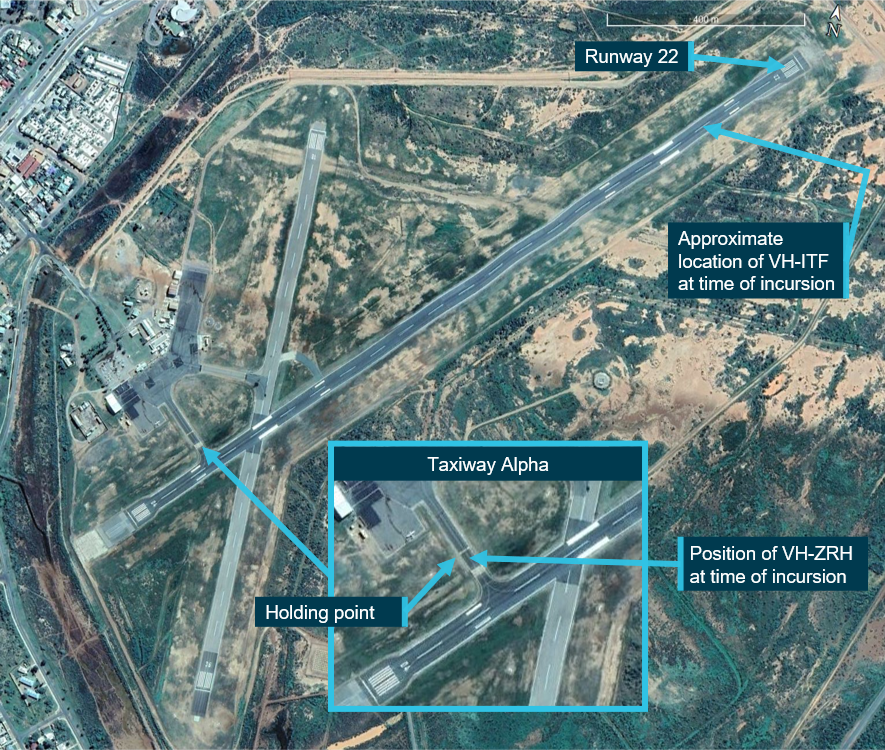
An incident where a SAAB 340 regional airliner crossed the holding point to enter the runway when another aircraft had commenced its take-off roll illustrates the effects expectations can have on how pilots perceive information, an Australian Transport Safety Bureau investigation report notes.
The Regional Express operated SAAB 340B, with a crew of three and 30 passengers, was being prepared to operate a flight from Carnarvon to Perth on the afternoon of 31 August 2020.
When the SAAB’s first officer was outside the aircraft conducting preflight inspections and the captain was on the flight deck, they both observed a Piper PA-31 twin-engined light aircraft taxi past them, and onto runway 22 via taxiway Alpha.
Neither SAAB pilot was monitoring Carnarvon’s local common traffic advisory frequency (CTAF) yet – nor were they required to be – so they did not hear the PA-31 pilot’s taxi call.
Carnarvon’s taxiway Alpha is at the southern end of runway 22, so aircraft are required to backtrack – taxi along the runway – before turning around and beginning their take-off roll.
Once on the runway, the PA-31, which was operating a Shine Aviation service to Geraldton with a pilot and two passengers on board, began to backtrack towards the threshold.
About three minutes after the PA-31 taxied past them, the SAAB pilots contacted Melbourne centre air traffic control to advise taxi details. Melbourne centre advised them to standby.
While waiting for Melbourne centre, the captain directed the first officer to broadcast on the CTAF that they were about to taxi.
“While the pilot of the PA-31 heard the SAAB crew’s taxi call, they did not respond on the CTAF,” ATSB Director Transport Safety Dr Michael Walker said.
“The SAAB then commenced taxiing for runway 22.”
Shortly after they commenced taxiing, the SAAB pilots were advised by Melbourne centre that the PA-31 was taxiing at Carnarvon for Geraldton and had planned the same route as them at 9,000 ft.
“However, the SAAB pilots later advised the ATSB that in their experience, air traffic control will provide the same information about another aircraft until they receive a departure call from that aircraft, which can occur some time after take-off,” Dr Walker said.
“Both pilots of the SAAB believed the PA-31 had already departed by the time they were ready to taxi, later stating they estimated at least 10 minutes had elapsed since they observed it taxiing past them.”
Based on the recorded radio transmissions, the ATSB estimated only about five minutes had passed.
“The SAAB crew said their belief the PA-31 had already departed was further enforced when they did not hear a response to their CTAF call, and did not observe any traffic on their traffic collision avoidance system (TCAS).”
When the SAAB arrived at the holding point for taxiway Alpha, the captain looked left up the runway, towards where the PA-31 was preparing to commence its take-off roll. The captain stated they did not see the other aircraft on the runway.
“At about this time, Melbourne centre passed traffic information to the PA-31, and the pilot of the PA-31 broadcast on the CTAF they had lined up and were rolling on runway 22,” Dr Walker said. “The SAAB flight crew did not hear either of these transmissions, possibly because their attention was diverted to confirming the assigned transponder code.”
Additionally, the SAAB flight crew later recalled that transmissions from the PA-31 were faint and quite scratchy, and this was supported by the aerodrome reporting officer (ARO) present during the incident.
The ATSB’s review of the CTAF recording noted the PA-31’s transmissions were distinctly weak in comparison to those from the SAAB and the ARO, but they were still audible and understandable. There was also no indication that the PA-31’s transmissions to Melbourne centre were degraded in any way.
“Since they believed the runway to be clear, the first officer of the SAAB broadcast they were entering and backtracking runway 22,” Dr Walker continued.
As the SAAB passed the holding point on taxiway Alpha, the pilot of the PA-31 commenced the take-off roll. The PA-31 pilot heard and observed the SAAB enter the runway and immediately advised them they were rolling.
The PA-31 subsequently rejected their take-off, and began backtracking again. The SAAB stopped a few metres past the holding point, prior to crossing the edge of the runway.
“This runway incursion incident highlights the potential effects that expectation can have on how a flight crew perceives information,” Dr Walker said.
“The ATSB found that although both flight crews were aware that they were mutual traffic, they both had an incorrect understanding of the other’s position and/or intentions, which led to them not recognising the potential conflict and therefore not directly communicating with each other.”
In addition, the investigation found that the lookout conducted by the SAAB’s pilots prior to entering the runway was not effective and likely to have been influenced by their expectation that the PA-31 had already departed.
Dr Walker said it is important that flight crew remain vigilant while maintaining situational awareness to counter expectation bias.
“Pilots should not hesitate to contact another aircraft if there is any uncertainty as to their position and/or intentions.”
Read the report: Runway incursion involving a SAAB 340B, VH-ZRH, Carnarvon Airport, Western Australia, on 31 August 2020


